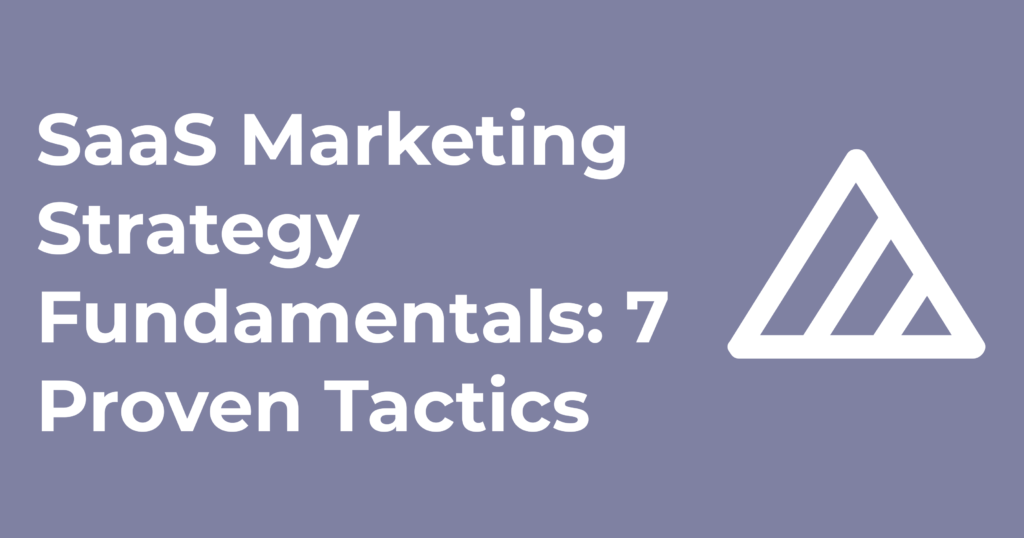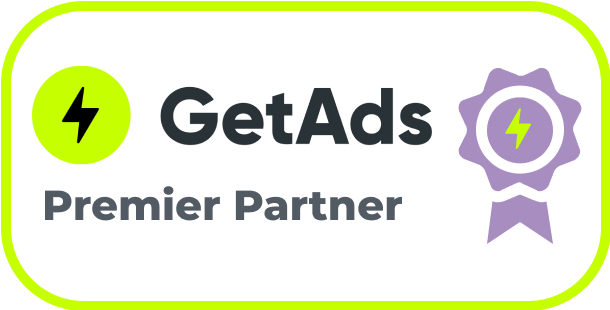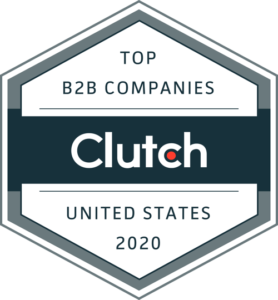According to the leading research company Gartner, worldwide SaaS revenue will reach $278 billion in 2021. It’s a meteoric rise compared to just five years earlier, when the SaaS market sat at a more modest $87 billion. But for anyone keeping tabs on the industry, perhaps it comes as no surprise.
Short for “software-as-a-service,” the SaaS business model, in which companies essentially lease out their software to customers through cloud technology, first came about in the 1960s. It wasn’t until the last decade that it began exploding in popularity, though—so much so that even traditional software companies have adopted the SaaS model.
One notable example is Adobe.
Once upon a time, Adobe offered its products as licensed software in the form of CD-ROMs. But the company saw and took note of the growing trend toward subscription-based software, recognizing that it could mean a more stable stream of revenue. It made the leap in 2012, and received overwhelming customer support in response.
Of course, not every software brand has the luxury of Adobe’s history and brand recognition. For those new to the industry, it can be difficult trying to figure out how to set your business apart, especially without a strong SaaS marketing strategy.
SaaS Marketing vs. Traditional Marketing
But first, what makes marketing for a SaaS company different from marketing for a traditional business model?
Consider mattress stores. The average mattress has a lifespan of eight years before it needs to be replaced. This business model succeeds because even though a single consumer won’t generally return to buy another mattress for nearly a decade, mattresses are extremely expensive. Moreover, most people use them.
Thus, thanks to their markup and ubiquity, mattress stores can sell a relatively small number and yet still make a profit.
SaaS companies work in nearly the opposite way. Since they’re subscription-based, long-term customer retention is a must. After all, attracting a new customer costs five times more than retaining a currently existing one. But that’s not easy when the competition is stiff. Just take a look at the growth of SaaS businesses in the last two decades.

It’s a crowded industry, making it all the more crucial for SaaS businesses to focus on their marketing. Specifically, compared to more traditional business models, they must prioritize:
- Establishing a strong customer base
- Providing quality information
- Outshining competitors
These are all, unfortunately, much easier said than done.
But if you need some help getting started with promoting your own SaaS business, check out these seven marketing strategies below.
7 SaaS Marketing Strategies to Elevate Your SaaS Brand
1. Full-Funnel Content Marketing
Content marketing is nothing new. In fact, businesses have been promoting themselves for centuries with original content like newsletters and magazines. While the SaaS model takes a newer approach to business, content marketing is still relevant, as information is key for moving leads along the sales funnel.
Of course, the type of content created should be tailored specifically to each stage. Here’s an idea of how that might look:
- Awareness – Create blog posts, infographics, and explainer videos. The goal of content in this stage is to educate and inform potential customers of the problem your software helps to solve—even if users aren’t aware that such an issue exists.
- Consideration – By this point, leads are interested, although perhaps not ready to convert just yet. Use product comparison charts, in-depth case studies, and detailed product descriptions to move them further along.
- Purchase – You’re ready to pitch your software to users at this point. To do so effectively, make your CTA clear and actionable. If possible, take advantage of social proof, like satisfied customer testimonials and reviews.
- Loyalty – When it comes to SaaS products, developing a long-term client relationship is paramount. Nurture customers into becoming repeat buyers through email outreach, rewards programs, and exclusive content, like insider guides and tips.
- Advocacy – Finally, turn your loyal customers into brand ambassadors by collecting success stories and implementing referral programs. Just remember that new customers don’t become advocates overnight; you’ll need to spend time cultivating retention in the previous stage before making it here.
For an example of effective SaaS content marketing, look no further than Marketo. The marketing software automation brand’s website is chock-full of content for all stages of the sales funnel—blog posts, ebooks, and customer success stories, to name a few.

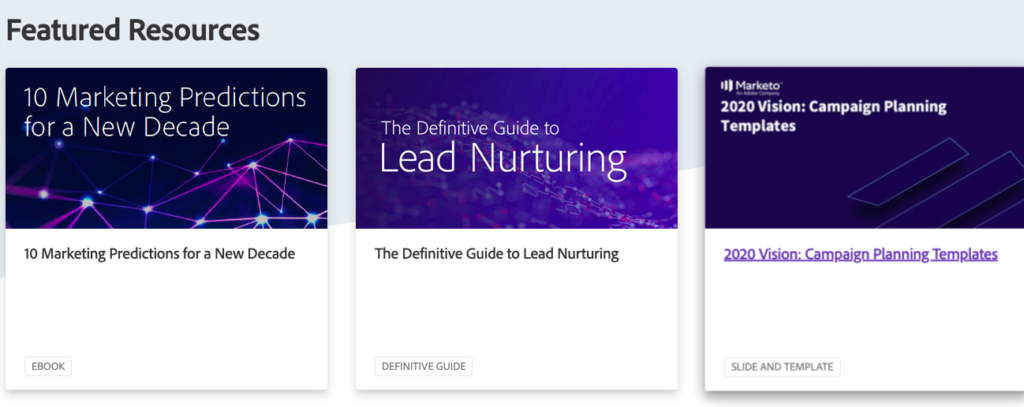
The result: a holistic and information-rich content marketing strategy that’s helpful to leads at all points of the buyer’s journey.
2. Search Engine Optimization (SEO)
Just because a piece of content is well-written doesn’t mean it’ll appear at the top of Google’s search results. It needs to be optimized for search engines; otherwise, it’ll have little chance of getting passive organic traffic.
What does search engine optimization (SEO) even entail in the first place, though?
Broadly speaking, there are two major categories of SEO—and it’s worth investing in both for a more successful SaaS marketing strategy:
- On-page SEO – These optimization techniques are focused solely on your website, and involve a combination of copywriting, design, and formatting. That includes making your web pages indexable, using smart keyword placement, writing descriptive image alt text, and other changes directly made to your site’s HTML source code.
- Off-page SEO – Off-page SEO involves optimizing for external signals to your site, generally through content promotion and outreach. This often means guest posting, influencer marketing, and link-building outreach. The goal of these efforts is to improve your site’s reputation by enhancing its authority, relevance, and trustworthiness. Potential customers want to know that your SaaS services are real, after all.
Together, these form the basis of a holistic SEO strategy that can drive more relevant users to your SaaS website.
For some inspiration, consider the sales and marketing software business HubSpot. It’s an absolute behemoth when it comes to SEO.
According to SEMrush, HubSpot’s content ranks for nearly 1.5 million organic keywords, more than 15% of which it holds a position for on the first page of Google’ search results.

By dominating search results with content targeted toward its audience, HubSpot makes it incredibly difficult for any competitor to edge in.
3. Pay-Per-Click Advertising (PPC)
SEO and paid advertising aren’t mutually exclusive; many brands simultaneously invest in SEO as well as pay-per-click advertising (PPC) to increase their web visibility. While highly optimized content can bring in visitors organically, it takes time to develop—and to see success in search engine results. Paid search offers a shortcut, generating immediate leads for your SaaS brand even if you’re the new kid on the block.
With Google receiving more than 63,000 searches per second, it’s probably no surprise that the biggest PPC channel worth investing in is Google Ads.
You can think of using Google Ads as kind of like skipping the line because you paid for VIP tickets. Getting content to rank organically on the first page of Google’s results is far from easy—it takes a lot of time, effort, and patience. But with Google Ads, a landing page of your choice can get there almost immediately.
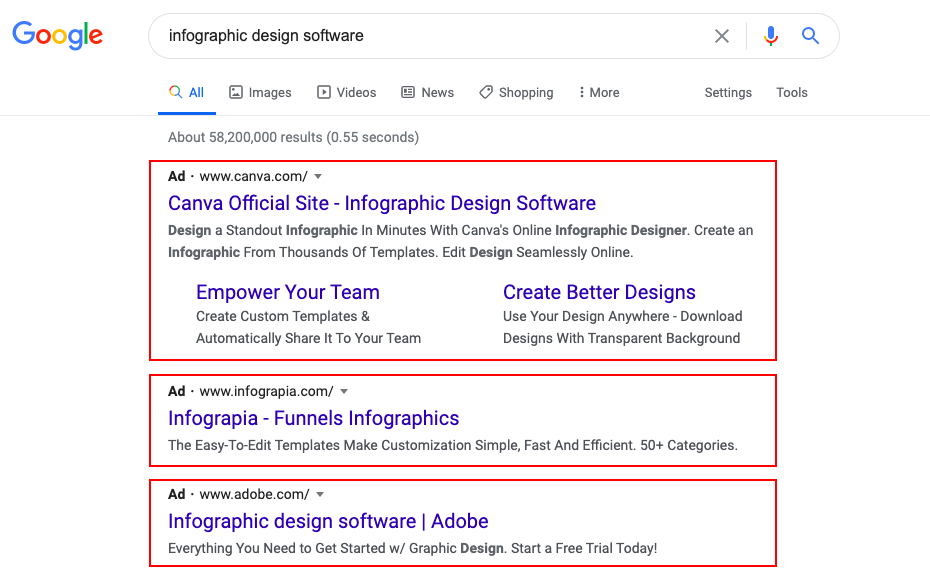
Simply put, a well-executed PPC campaign on Google Ads can translate into hundreds, even thousands, of ad impressions in a short period.
So what are the key components of a strong PPC strategy? You need:
- Relevant keywords that align with your software service
- Optimized landing pages with clear CTAs
- Solid copywriting skills for crafting your ads
Of course, there’s an obvious downside to PPC—the fact that it’s paid advertising.
There’s no minimum spend to use Google Ads, but you can’t expect much from a daily budget of $5. (As a starting point, we recommend a monthly budget of $2,000 to $10,000.)
However, more importantly, you need the know-how. Without a strong understanding of PPC and a fine-tuned strategy, you may as well be throwing money down the drain.
You need a dedicated expert to guide your PPC strategy—but that doesn’t necessarily mean you have to hire an in-house PPC guru. Depending on your budget, it’s worth outsourcing your PPC strategy and management to an agency like Fantom.
4. Paid Social Advertising
Like PPC, paid social advertising provides another quick avenue for reaching customers. There’s the obvious benefit of increasing conversions, but that’s not all paid social media ads are good for.
They’re perfect for enhancing your SaaS company’s brand awareness.
Remember that the SaaS industry is heavily saturated, with new businesses and innovative products emerging each day. To gain even the smallest amount of traction, you need some baseline level of brand awareness and recognition. It helps make your business more credible and familiar as opposed to scammy or too-good-to-be-true.
And since nearly 3 billion people use social media worldwide, paid social ads are an excellent place to start.
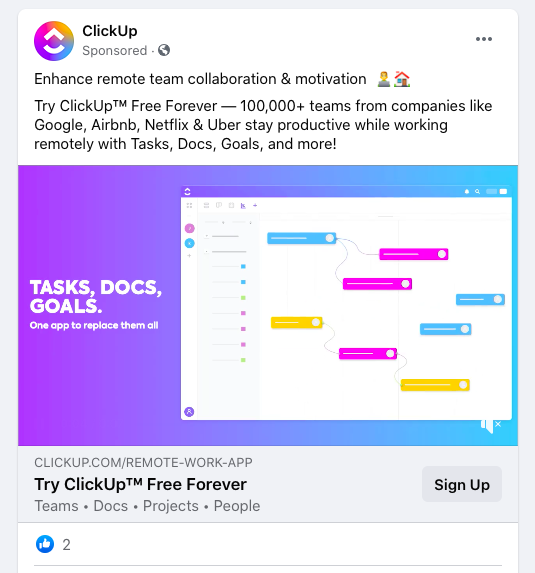
Some key tips for an effective paid social campaign include:
- Get super specific with your targeting. Don’t skimp on researching your target audience—get as granular as you can. For instance, consider the interests, job titles, and behaviors of your ideal SaaS customer. Segmentation leads to better results than general or vague ads that try to capture everyone.
- Experiment with scheduling. Ad performance will vary depending on the day of week and time of the day. Take advantage of A/B testing to optimize and tweak your social ad campaigns as need be.
- Lead users to something valuable. What can you offer to pique users’ interest and get them to click? It could be a blog post, ebook, case study—whatever it is, make sure it’s something readers will find valuable.
- Follow design best practices. Compared to PPC, social ads have a stronger visual element. Just take a look at any of the ads you see on Facebook, Twitter, Instagram, and LinkedIn. For improved performance, choose an image that’ll stand out against the background of the given social media network, and include helpful, informative text.
There’s a common misconception that social media advertising is easy and straightforward. In reality, it’s a lot more complex. Fortunately, outsourcing is a cost-effective option for SaaS startups unable to hire a full-time social media buyer.
5. Product Demos and Free Trials
They say the proof is in the pudding—and that’s exactly the thinking behind offering product demos and free trials.
By testing a new software themselves, customers get a better sense of how it works and whether it’s worth investing in long-term. It’s a surefire way to generate more leads, and it’s also why so many SaaS businesses offer “freemium” versions of their software.
Of course, not every SaaS company can offer a freemium version to attract customers. If that’s the case for you, you’ve got all the more reason to offer a product demo or a free trial.
Product Demos
Robert Falcone, cofounder of the marketing software maker Monetate, observes that “knowing your product doesn’t make a demo successful.” In other words, there’s a lot more to a demo than simply knowing all of your software’s ins and outs.
To prepare for a demo, consider these two questions:
- What are your target audience’s greatest pain points?
- Where does the most value come from in your SaaS product?
Your software may have hundreds of impressive features, but that can be overwhelming for leads who simply want to know its primary value.
So make your demo customer-centric. Highlight the core features of your software that directly address consumers’ pain points, and avoid diving into the details that don’t contribute as much outright value.
Free Trials
Research by Totango suggests that on average, only 15% to 20% of free trial users actually become paid customers. To get more free trial users to convert, be sure to:
- Avoid asking users to provide credit card information. Totango’s research shows that overall, the end-to-end conversion rate is higher when companies don’t ask for payment information.
- Make your pricing clear. Whether it’s in a landing page or email message, don’t be sneaky about how much your service costs.
- Shorten your trial. Very few users will use your service for more than three consecutive days. For more engagement and a shorter sales cycle, limit your trial to two weeks.
- Be proactive in your communication. Engage users by sending a welcome email and helpful tips. One great example of this is Airtable, which sends email reminders letting users know when their trial will expire and what premium-only features are worth trying out.
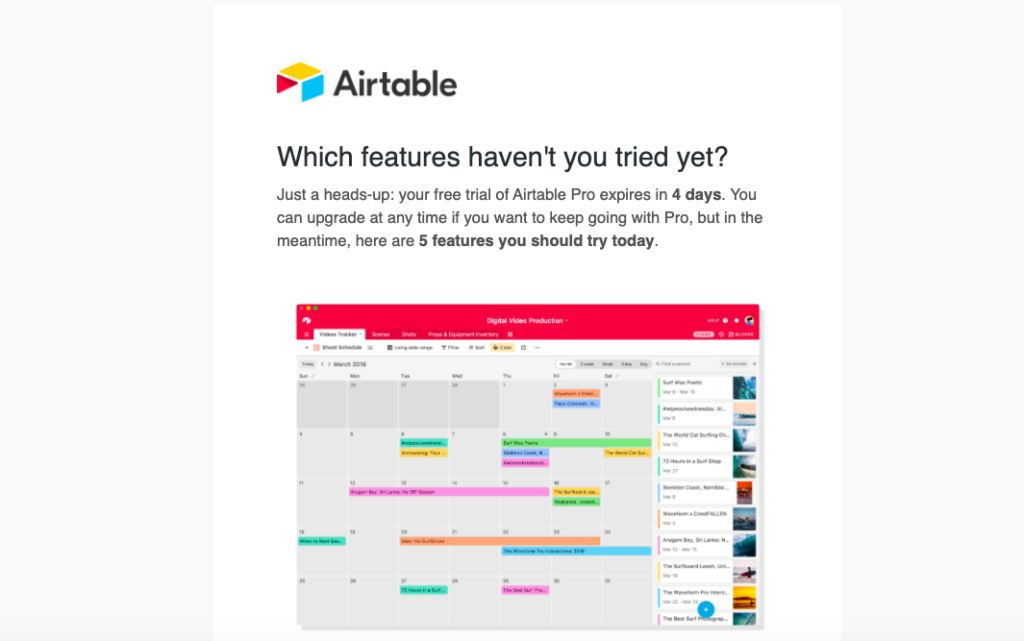
6. Referral Marketing
According to a special report by Edelman, the world’s largest PR firm, consumer trust in brands is waning—only 34% of consumers say they trust the brands they buy and use. This dismal stat is remarkably telling of the public’s growing skepticism of mainstream media, but not all hope is lost.
To build consumer trust, try referral marketing.
Also known as word-of-mouth marketing, this strategy involves encouraging current customers to refer their contacts to your business. It works because no matter the industry, consumers are more likely to make a purchase if they’ve heard a recommendation from a friend or family member. In fact, 82% of American consumers actively seek out recommendations when considering a purchase.
But aside from an increased likelihood of conversion, referrals also differ from other leads in terms of quality. How so? Research suggests that customers that come through referrals have a 37% higher retention rate, making this type of marketing all the more critical for SaaS companies.
When setting up your referral program, keep these best practices in mind:
- Choose a meaningful, non-monetary reward. Surprisingly, non-cash incentives are actually 24% more effective than cash incentives.
- Make your referral program available for a limited time. This helps create a sense of urgency compared to a program that’s ongoing—and makes the reward all the more enticing.
- Actively publicize your referral program. Mention it on social media, in email outreach, or in a CTA on your website’s sidebar. You won’t score any referrals if no one’s aware that such a program exists, after all.
- Make your referral program easy to share. Encourage more customers to participate by giving them a custom link or adding social share buttons to your landing page.
For an example of successful SaaS referral marketing, check out Trello.
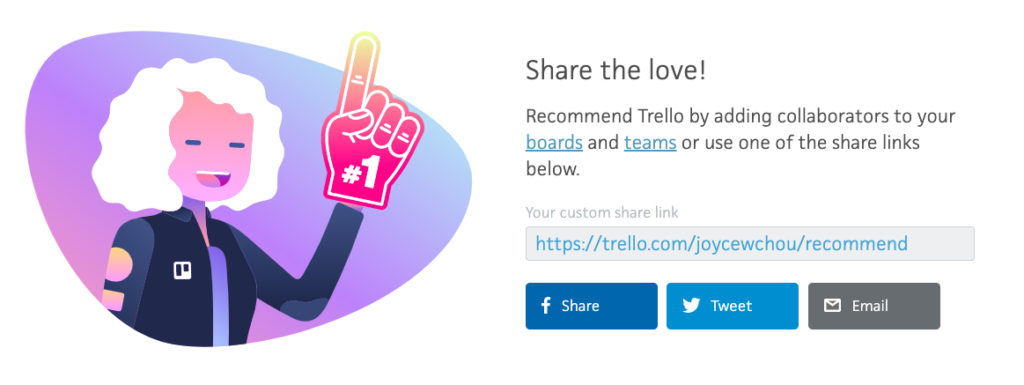
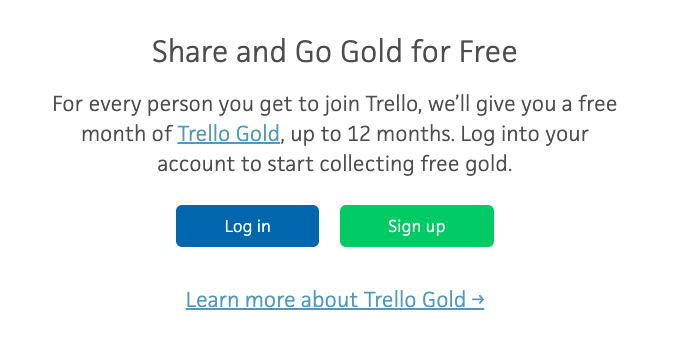
The project management software has a dedicated landing page for its referral program and offers a custom link for users to easily share. In return for every successful referral, users earn a free month of Trello Gold, a software upgrade with special perks.
7. Retargeting
Finally, there’s retargeting, a marketing tactic that involves tracking site visitors and showing ads for your brand in the effort to re-engage them. You’ve probably seen this if you’ve ever done some online shopping: after checking out a retail website, ads for it begin appearing as you browse social media or other sites.
It may sound creepy, but there’s a point in retargeting.
As much as we’d like for the buyer’s journey to be one linear movement, it’s hardly ever so predictable. Oftentimes, users land on a page through an ad or organic search—and then leave without ever converting.
By retargeting, also known as remarketing, sites stay top-of-mind, making consumers 70% more likely to convert. It’s a strategy built on increasing your brand exposure so that users won’t just forget about your service; instead, they’ll give more thought to making a purchase. And it’s not just for ecommerce—SaaS companies certainly benefit from retargeting as well.
Here’s an example of Mangools, a Slovakian SaaS business, with retargeting at work on CNN’s website.

Retargeting doesn’t only come in one shape or size, by the way. It can get incredibly nuanced, depending on your strategic priorities. For example, you could retarget users based on:
- Whether they’ve abandoned your signup page
- How frequently they’ve visited your site
- Whether they’ve liked, shared, or commented on one of your social media posts
- What stage of the sales funnel they’re in
- Whether they’ve opened any emails from your brand
- And more!
Given how competitive the SaaS space is, retargeting is a game-changer for enhancing your brand recognition and maintaining consumers’ interest.
Conclusion
The SaaS space is getting increasingly crowded—and projections for the industry suggest it’s not slowing down anytime soon. With so much competition vying for a share of the market, creating and executing a holistic SaaS marketing strategy is a must.
That doesn’t mean you should invest in all seven of the aforementioned strategies at once, though. Even if you had the budget, going full blast could mean spreading your team and resources thin.
Instead, start with one or two marketing strategies. Experiment to see what works, and adjust and adapt them to your SaaS brand accordingly. Over time, you’ll have a better idea of what specifically works for your SaaS company and how to maximize your marketing efforts.

